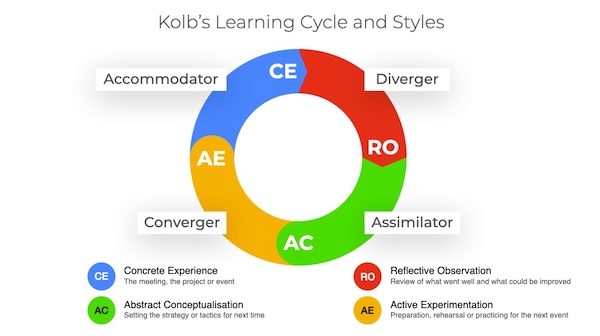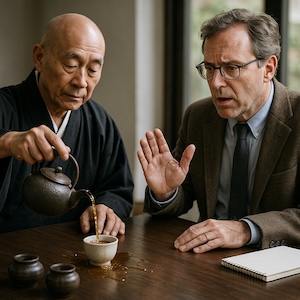This article is part of a series called, Surface Tension. The introduction article contains links to all other articles.
When I work with executive teams discussing strategy, I often ask when they last stopped to do nothing but think about their business. Most look at me as if I'm mad while listing innumerable operational responsibilities and pointing out the obvious—that, of course, they don't have time to think.
I then ask, "If none of the executives are thinking, then what is driving all the activity in the organisation?" This provocative question challenges the pervasive belief that thinking isn't real work for executives.
The most effective organisations build in deliberate pauses—not as a luxury but as a necessity. These reflective spaces allow unconscious patterns to become visible and learnings to integrate before the next action cycle.
The Cost of Continuous Action
The relentless pace of business creates a paradox: we're too busy executing to reflect on whether we're executing the right things in the right ways. This continuous action without pause creates a perfect environment for surface tension to thrive—maintaining appearances while hiding deeper dynamics.
Research on organisational learning reveals that teams without structured reflection consistently repeat the same mistakes. What appears to be experience—"We've been doing this for years"—is often just the same experience repeated without the learning that transforms it into intelligence.
Reflection in Action
Donald Schön, whose work on "reflection-in-action" transformed professional practice, observed that effective practitioners don't just execute tasks but simultaneously think about what they're doing.
This reflective capacity allows them to adjust and develop deeper understanding in real-time. It's not separate from action but integrated within it—the ability to operate while simultaneously watching oneself operate.
Ray Dalio's Bridgewater Associates has institutionalised reflection through rigorous after-action reviews of investment decisions. What makes these reviews psychologically sophisticated is their explicit attention to the thinking that produced the decisions.
Teams examine not just what happened but the mental models and emotional states that influenced their judgment. This practice transforms isolated experiences into organisational intelligence that compounds over time.
The Band of Brothers
Admiral Horatio Nelson created a similar practice with his captains. Before battles, he hosted dinners where they discussed tactical plans and the thinking behind them.
These dinners created what naval historians call Nelson's "band of brothers," a leadership team with such deep shared understanding that they could act with coordinated autonomy in the chaos of battle.
The engineering firm Arup adapted this approach through "Knowledge Pauses"—structured reflections at key project milestones that examine the relational and psychological dimensions of the work. "We found that the most expensive project failures rarely stemmed from technical incompetence," explained one Arup principal. "They came from unacknowledged conflicts, status competitions, or fears that weren't surfaced until it was too late."
Making the Hidden Visible
The power of deliberate pause lies in its ability to make visible what continuous action obscures:
- Unexamined assumptions that limit options without awareness
- Emotional patterns that shape decisions beneath rational awareness
- Group dynamics that allocate informal power and influence
- Implicit prioritisation that doesn't match stated priorities
Without structured pauses, these forces remain hidden, creating surface tension that maintains the appearance of rational strategy while unconscious forces determine actual outcomes.
Implementation Insight
David Kolb's learning cycle and learning styles provide a practical framework for building reflection into your organisation:
The Learning Cycle:
- Concrete Experience - Engaging in the activity
- Reflective Observation - Reviewing what happened
- Abstract Conceptualisation - Drawing conclusions and learning
- Active Experimentation - Planning and testing what was learned

We can use a sports analogy to explain this cycle. Concrete experience is the match on the weekend; watching the video highlights and evaluating the game on Monday is reflective observation. Strategising about next week's match is Abstract Conceptualisation, and practices for the next game are Active Experimentation.
In business, we apply the same process to client pitches, staff presentations, key projects, or change initiatives. We do the event, step back afterwards to reflect by asking two simple questions: What went well, and what could we improve? We plan for the next event and rehearse before we get there.
In addition to this learning cycle, we each have preferences for where we learn best. I am an Accommodator, combining Active Experimentation and Concrete Experience. I love jumping in and getting things done. This doesn't mean I can't spend time in other styles—I've learned to reflect and plan to be effective—but I can more easily be an Accommodator than an Assimilator (the opposite style).
A business wanting to improve customer experience might apply this by having team members participate in customer meetings (concrete experience), conduct debrief sessions to analyse interactions (reflective observation), develop new customer engagement principles (abstract conceptualisation), and test these approaches with a subset of customers before full implementation (active experimentation).
Implementing Structured Reflection
Start with these practical approaches:
- Project pre-mortems and post-mortems - Before beginning a project, ask, "If this fails, what will have caused it?" After completion, examine what happened versus what was expected.
- Quarterly pause sessions - Schedule dedicated time where executive teams step away from operations to reflect on patterns, not just results.
- Decision journals - Have leaders document their thinking when making significant decisions, creating a record that can be reviewed when outcomes emerge.
- Modified after-action reviews - Beyond asking what happened, explore the thinking and emotional states that produced actions.
Following this approach requires time investment, but it's a classic case of spending a small amount upfront to avoid misalignment and mistakes that lead to massive time loss later.
The Reflective Leader: Beyond Doing to Being
Building intelligence through pause gradually shifts leadership from doing to being. Leaders who embed reflection into their practice develop what Ronald Heifetz calls "getting on the balcony"—the ability to simultaneously participate in the organisation while observing it with detachment.
This capacity doesn't emerge from personality but from practice. By consistently creating spaces where thinking is valued as much as action, leaders develop the reflective consciousness that allows them to work with, rather than be unconsciously driven by, the surface tensions in their organisations.
As one CEO who instituted quarterly reflection sessions noted: "I used to think my job was making decisions. Now I understand my job is creating the conditions where better thinking produces better decisions throughout the organisation."

Looking Ahead: From Reflection to Polarities
Building intelligence through pause strengthens your capacity to navigate the complex tensions that shape organisational life. In our next article, we'll explore Strategy Five: Beyond Absolute Answers: The Power of Polarity Thinking—how to manage the ongoing tensions that don't resolve into single answers but require continuous balancing.
The deliberate reflective pause creates the foundation for this more sophisticated approach to leadership challenges, allowing you to recognise when you're facing problems to solve versus polarities to manage—a distinction that transforms leadership effectiveness at senior levels.
